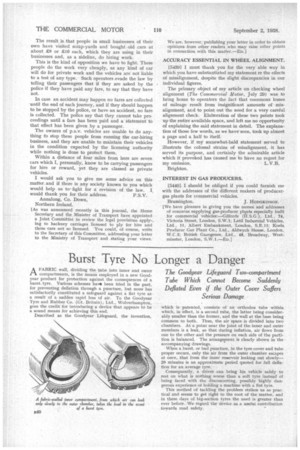Burst Tyre No Longer a Danger
Page 50

If you've noticed an error in this article please click here to report it so we can fix it.
The Goodyear Lifeguard Two-compartment Tube Which Cannot Become Suddenly Deflated Even if the Outer Cover Suffers Serious Damage
AFABRIC wall, dividing the tube into inner and outer compartments, is the means employed in a new Goodyear product for protection against the consequences of a burst. tyre. Various schemes halo been tried in the past, for preventing deflation through a puncture, but none has satisfactorily constituted a safeguard against a flat tyre as a result of a sudden rapid loss of air. To the Goodyear Tyre and Rubber Co. (Gt. Britain), Ltd., Wolverhampton, goes the credit for introducing a device that appears to be a sound means for achieving this end.
Described as the Goodyear Lifeguard, the invention, which is patented, consists of an orthodox tube within which, in effect, is a second tube, the latter being considerably smaller than the former, and the wall at the base being common to both. Thus, the air space is divided into two chambers. At a point near the joint of the inner and outer members is a leak, so that during inflation, air flows from one to the other and the pressure on each side of the partition is balanced. The arrangeeent is clearly shown in the accompanying drawings.
When a burst, or bad puncture, in the tyre cover and tube proper occurs, only the air from the outer chamber escapes at once, that from the inner reservoir leaking out slowly20 minutes is an approximate period quoted for full deflation for an average tyre.
Consequently, a driver can bring his vehicle safely to rest on what is nothing worse than a soft tyre instead of being faced with the disconcerting, possibly highly dangerous experience of holding a machine with a flat tyre.
This method of tackling the problem strikes us as practical and seems to get right to the root of the matter, and in these days of big-section tyres the need is greater than ever before. We regard the device as a useful contribution towards road safety.




















































































